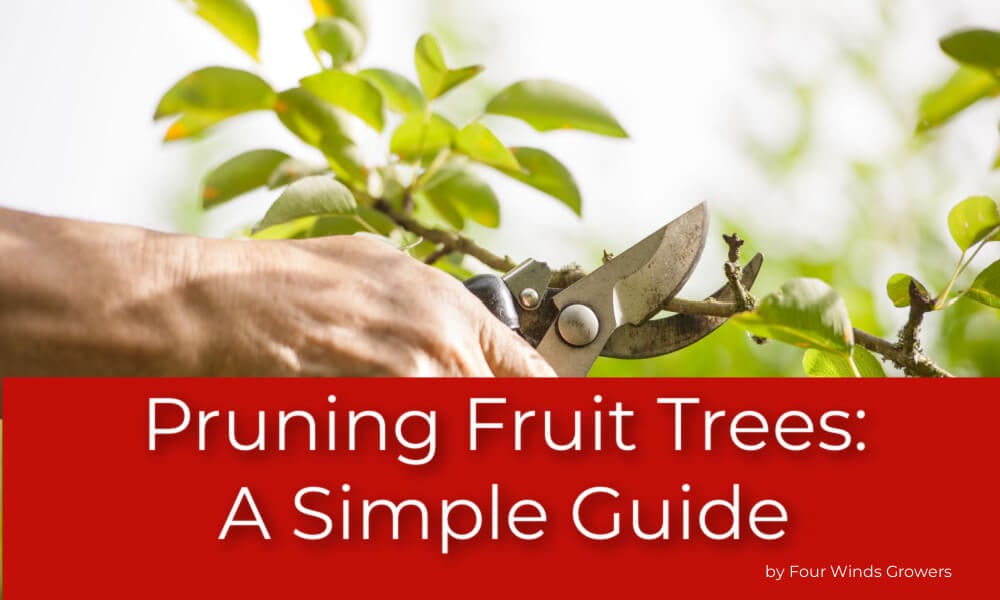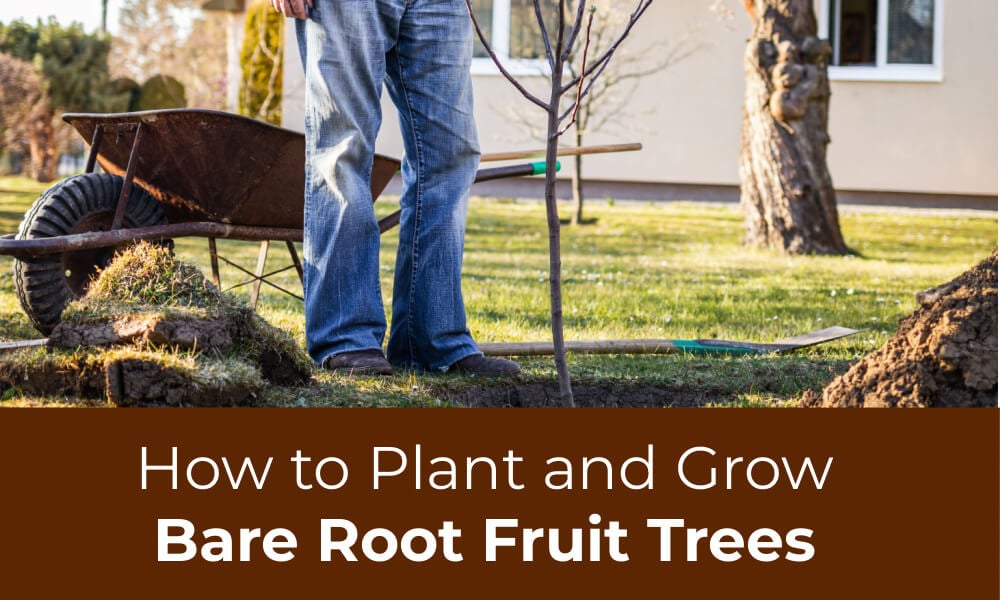Pruning fruit trees is an important task that serves several purposes for your fruit tree but knowing when to prune, what to prune and how much to prune are key to the success of your fruit tree. Pruning fruit trees is very much an art and if you ask 5 professionals to come prune the same tree, they would likely all prune differently and do a good job. Read more on how to prune fruit trees properly.
Why we prune: Pruning is the practice of removing specific parts of a tree to redirect energy into other parts of the tree to improve tree health and visual appeal. We prune to maintain tree health by removing dead, damaged and diseased wood. This process will increase air flow to prevent future disease. Furthermore, we want to reduce the density of branches to allow more even light within the tree for more even ripening and growth. By reducing the over all mass of the tree it will make it easier to manage. You can rejuvenate your tree by simply removing suckers and water sprouts thus redirecting energy into productive growth.
When to prune: For all of those that ask, when is the best time to trim fruit trees? Pruning should be done in late winter or early spring while the tree is still dormant and before any new growth begins. Try to prune during a one to two week break in the rain if possible to reduce your chances of fungal disease. This could be as early as January to as late as May depending on your climate. Pruning fruit trees in the fall will also benefit many varieties which can be done once harvest is over.
Tools & Equipment: Before we start pruning, you will want to gather the proper tools and safety equipment. A freshly sharpened set of hand pruners will be perfect for branches less than an inch in diameter. A set of loppers for branches less than 3" in diameter is quite handy for those slightly bigger cuts. My favorite tool is a pruning hand saw for branches less than 6" in diameter. These saws are ridiculously sharp and leave very clean cuts. I typically use these more than loppers. Make sure to make undercuts when sawing off larger branches to prevent tear out. The last tool is a pole pruner for the hard to reach branches. Not all of the tools are necessary but having the right tools for the job makes pruning much easier. Long sleeve, gloves and safety glasses are very important for keeping your hands, arms and eyes protected from thorns and falling foliage. It is recommended that you spray your tools with a disinfectant between trees to prevent the spread of diseases.
Fruit Tree Pruning Basics: Pruning Terms
-
Axil: The angle between a leaf or branch and the stem or trunk of the plant from which it arises.
-
Bud: An unexpanded shoot that will form vegetative growth or flowers. They can be terminal if found at the top of a shoot or lateral if at the axil of a leaf.
-
Central Leader: A pruning style that leaves a single, strong trunk from which side branches are encouraged to grow. (Commonly used in Apples, Pears, Plums & Cherries)
-
Espalier: A pruning/training style that forms a tree flat against a trellis or wall.
-
Fruiting wood: Branches carrying flower buds with the potential for bearing fruit.
-
Fruit Spur: Short, growth off of a branch that produces flowers. Common on Apples, Pears, Plums and Cherries.
-
Heading Back/ Heading Cut: This is the process of removing terminal growth in order to control size. This type of cut will also encourage lateral buds to grow.
-
Lateral Bud: This is a bud on the side of a stem rather than the tip.
-
Central Leader: A tree with a main trunk that is taller and stronger than any lateral growth. This results in an "A" shaped tree.
-
Modified Central Leader: This form of tree allows for a strong central leader that is headed back to create a shade crown to cover the interior of the tree which is made of of 3-4 main scaffold with even spacing between branches.(Commonly used in Apples, Pears, Figs, Persimmons, Plums & Cherries)
-
Open Center: This pruning system keeps the main trunk short and the center is kept open with 3-4 main scaffold limbs around the open center. Try to leave enough branching to protect the exposed interior or protect with Plant Guard tree paint / foliar spray or you may see sunburn and bark cracking come summer time.(Commonly used in Apricots, Nectarines, Peaches, Plums & Cherries)
-
Pinch: Pinching terminal buds with your fingernails will temporarily redirect vigor into lateral buds without need of a heading cut.
-
Scaffold: A branch that starts at the trunk.
-
Sucker: Vigorous growth emerging from the roots or below your scaffolds on the trunk.
-
Terminal Bud: The bud at the end of a branch or trunk.
-
Water Sprout: Vigorous growth emerging from latent buds on older branches
-
Whip: A 1-2 year old tree that has a single trunk with no side branches. (This is a great place to start training your new tree)
Technique: Cuts on live wood should be made above an outward facing bud with enough space above the bud to allow for some dieback and at an angle that allows for water to fall away from the tree. (See image above for reference) When pruning, avoid leaving stubs which will die back and rot over time. An optional step is to seal each cut with sealer like IV Organic Plant Guard which should be done promptly after pruning if done at all. This step is much more important on larger cuts as large open wounds make easy entry points for pests & disease.
Fruit Tree Pruning Basics: Maintenance
-
Begin by pruning off all dead, damaged, and diseased wood. If this is the only thing that you do, this alone will dramatically improve the health of your tree and is relatively easy as the tree as decided for you what needs to be cut. It is especially important to clean pruners after cutting diseased wood before moving on to any further cuts.
-
Prune off all suckers and water sprouts. Basically, both grow straight up and are mostly vegetative which will only pull nutrients away from the main structure of the tree. Removing these will increase airflow within the canopy and reduce competition form the suckers of the rootstock. Heading back water sprouts can be a good way to fill gaps in the tree and encourage the development of fruit wood.
-
Hanging branches are usually the result of heavy fruit load from a previous season, pulling the branch down into that space. Fruit set on these branches can end up dragging the branch all the way down the ground so these can also be pruned back.
-
Crossing branches should be removed in most cases to prevent branches from rubbing which will create wounds or potential entry points for pests and diseases.
If at this point, you have pruned about 1/3 of your overall tree canopy(not counting dead wood) you can go ahead and stop. If you are pruning an Avocado or Citrus tree, you can stop here as well. Pruning more than 1/3 of the tree canopy can cause the tree to react with excessive vertical shoots the next season. If you have pruned less than 1/3 of the tree, you can use the rest of your budget to prune for form. Everyone has their favorite methods depending on the tree variety, and this is something you will have to feel out with each tree you encounter.
Protect your tree from sunburn, insects & rodents with PLANT GUARD tree paint & foliar spray.
Protect your roots from rodents with ROOT GUARD the original gopher wire basket.
Feed your fruit tree with Romeo Plant Food. This water-soluble fertilizer is great for in-ground or in-container growing.
Author: Israel Osuna




